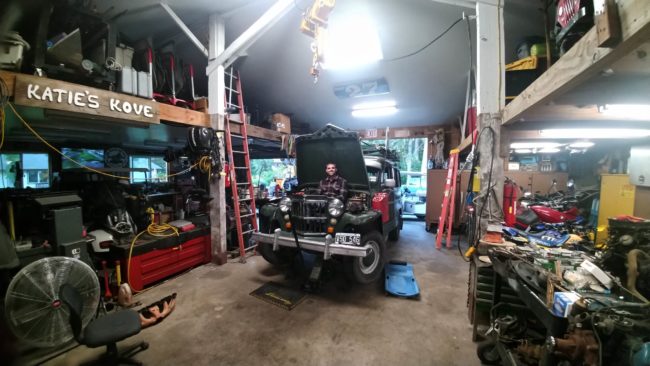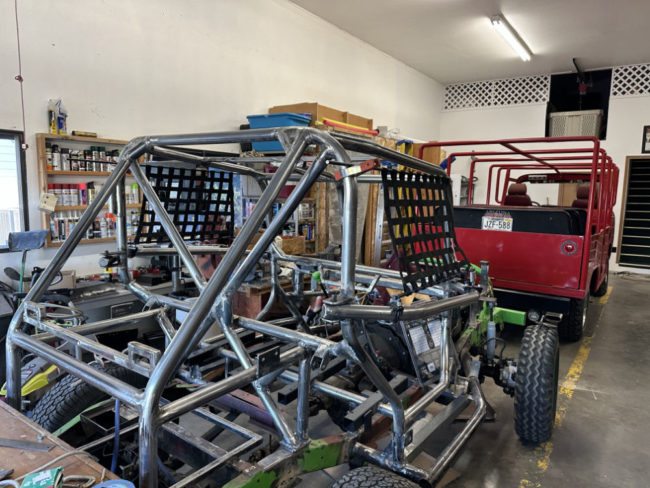Bill shared this nice story about a group of students who rebuilt a family’s jeep after the owner died.
https://www.washingtonpost.com/lifestyle/2023/08/06/jeep-mechanic-coronoa-students-porter/
Bill shared this nice story about a group of students who rebuilt a family’s jeep after the owner died.
https://www.washingtonpost.com/lifestyle/2023/08/06/jeep-mechanic-coronoa-students-porter/
Chris was wondering if anyone knows more about why this postcard describes these vehicles as “Phantoms”, especially when the look more like Ford GPs than Bantam prototypes?
Toby purchased a 1966 CJ-5 from an original owner and found this letter inside the owners manual. Note the last paragraph (no coverage for squeak and rattles, lol).
Bill shared this article about some modern-day jeeps you might not want to purchase. I really can’t say how accurate most of this article is, as I’ve never owned or driven any of these.
Roger Martin attended this year’s Toledo Jeep Fest this weekend. He brought along his 1947 CJ-2A, an M-677, and his FC Fire Truck. He also took photos of the jeeps at the show, along with some merchandise for sale and a few of the parade.
Roger Martin shared the news that a Roof Palomino group exists on Facebook. Given their rarity, I wouldn’t have guess that.
UPDATE: Andy Reached Alaska!
The intrepid explorer overcame his obstacles and made it to the Alaska border the other day. Congrats on the continuing journey!
https://www.facebook.com/groups/136590813628973/permalink/1330828404205202/
=======================
Originally posted May 30, 2023:

Andy, from Argentina, standing in his engine compartment at Washougal Classic Jeep while Richard and Jake work on his engine.
Recently, through Facebook, I was made aware of Andy, who is driving his Willys wagon from Argentina to Alaska. I lack many of the details, but I know that by early May Andy had made it all the way to Oregon when his engine finally gave out. Unable to go any farther, he and friends reached out through Facebook to find someone would could help him fix his engine (a couple posts on this FB page).
Richard Darr of Washougal Classic Jeep, near Vancouver, Washington, volunteered to help. While Andy stayed with a friend in Tigard, Oregon, Richard towed the vehicle to his place, diagnosed the problems:
“The engine has some serious issues for sure and the cracks have us spooked as well but we are going to try and breathe life back into this engine to hopefully finish the journey to Alaska. We really don’t know if the cracks happened recently or been there for quite some time. We are going to put a new timing set in and reseal the valves, clean out all the blockages in the cooling ports and new head gasket and top it off with a tune up and see what happens. Drive it around locally a bit to see how it takes. If it seems healthy enough to send Andy on his way then off he goes.. if not.. then we will have to switch gears and come up with a replacement engine or something. Jake and I are happy to do what we can to get Andy to the finish line of his more than 8 year Trek.”
After a couple weeks, Richard and Jake were able to repair the engine enough that Andy decided not to invest in another block. They test drove the wagon recently and are satisfied it is ready. Andy test drove it as well and says it is more powerful than it has been since Bolivia (I can only guess something happened to the engine there?). So, Andy is prepared to take off towards Alaska again.
During the process, did require Richard to spend $400 of his own money (plus all the time). I’m going to send Richard $200 to cover half his expenses. If anyone wants to donate as well, you can send money directly to me through PayPal (Payment@ewillys.com) and I will send Richard an additional check based on any donations (he doesn’t have PayPal). If you have any questions, just email me: d@deilers.com.
UPDATE: The weather was perfect, cloudy, not so hot, and windless, for painting the chassis outside.
================================
It’s been a busy few days. I completed the sidebars and netting, then washed the frame. It’s drying awaiting a new coat of paint. While I’d prefer to disassemble and properly clean and paint everything, that’s just not possible at this point.
There’s nothing much fancy about the side bars. A bolt secures the back of the bar and acts as the pivot point. A 3/8’s pin holds the front in place and is pulled to release the bar so a person can enter/exit the jeep. The netting is held in place at the front by a seat belt buckle. Undo that, then pull the bottom bar forward slightly, and the bottom of the net comes loose, then a person can swing the netting onto the top. (note, this phone was taken before I welded a short horizontal tube which will hold the back of the top netting bar in place .. the orange clamp was just to figure out where the tube should go).

With the bars and netting done, the mods are pretty much complete. Now, to clean, paint, and assembly. Hopefully, everything goes back to gather as it did before …
Here’s the chassis a little cleaner. My goal is simply to cover the green and paint the bare metal.
The front tires will go on some aluminum rims, while there will be desert dogs in the back. The back rims remain undecided. I’d rather not use the hurricane finned rims for the rear, but don’t want to crack them. I have some other aluminum rims for the back, but they are six lug, while the rear axle is now a five lug drum.
Frank shared this video showing the creation of a small jeep that can drive and park under its own power.
https://www.instagram.com/reel/CvBJ_dVAElK/?igshid=MTc4MmM1YmI2Ng%3D%3D